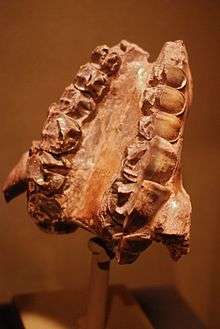Homalodotherium
| Homalodotherium | |
|---|---|
 | |
| Mounted skeleton of H. cunninghanni in the Field Museum of Natural History, Chicago | |
| Scientific classification | |
| Kingdom: | Animalia |
| Phylum: | Chordata |
| Class: | Mammalia |
| Order: | †Notoungulata |
| Suborder: | †Toxodonta |
| Family: | †Homalodotheriidae |
| Genus: | †Homalodotherium Huxley, 1870 |
Homalodotherium is an extinct genus of notoungulate mammals native to South America. Fossils of Homalodotherium have been found in the Middle Miocene (Friasian in the SALMA classification) Santa Cruz Formation of Argentina and the Río Frías Formation of Chile.[1]
Description

Homalodotherium was about 2 metres (6.6 ft) in body length, with a weight up to 300 kilograms (660 lb), and had long forelimbs with claws instead of hooves otherwise seen in related taxa. It walked on the soles of its hind feet and the toes of its front feet, which would have made the animal higher at the shoulder than at the hips when it walked on all fours. It was probably at least partially bipedal, being able to pull down tree branches with its arms while rearing up on its hind legs.[2] Various other prehistoric and living creatures have also developed this anatomical design and feeding style; examples are the chalicotheres, ground sloths (which shared the same environments), the giant panda, the gorilla and, possibly, the therizinosaur dinosaurs.
References
- ↑ Homalodotherium at Fossilworks.org
- ↑ Palmer, D., ed. (1999). The Marshall Illustrated Encyclopedia of Dinosaurs and Prehistoric Animals. London: Marshall Editions. p. 253. ISBN 1-84028-152-9.